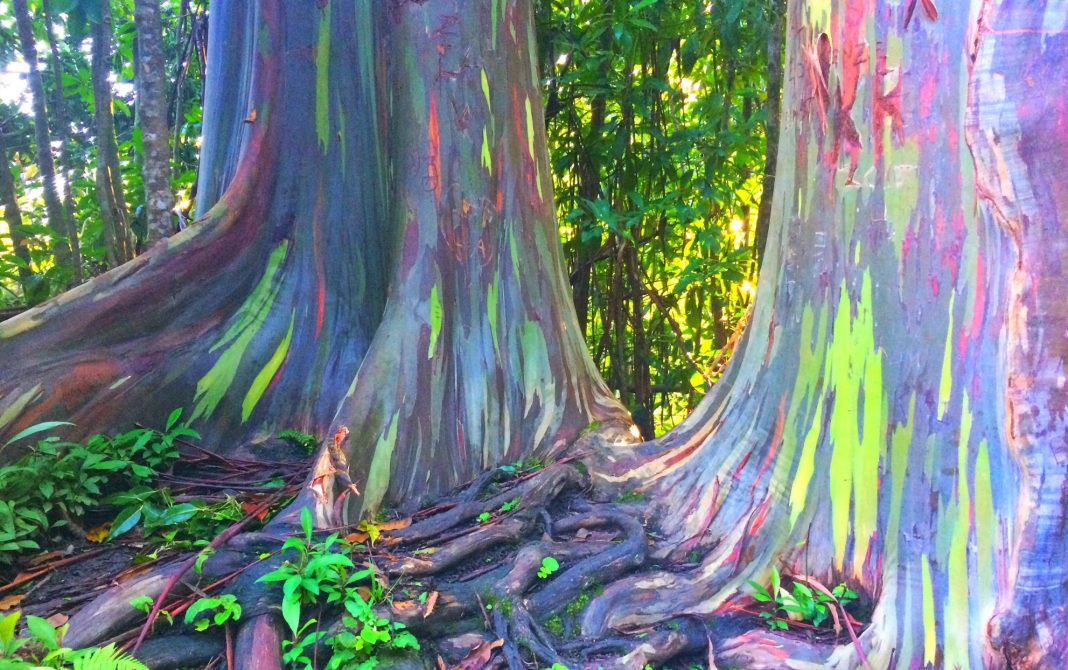Have you ever imagined strolling through a rainforest and encountering a tree unlike any other? Not adorned with vibrant flowers, but with a mesmerizing multicolored trunk – a kaleidoscope of emerald greens, fiery oranges, calming blues, and deep purples. This captivating wonder is the rainbow eucalyptus tree (Eucalyptus deglupta), a Southeast Asian native that stuns with its ever-changing bark.
Intrigued by this otherworldly display? Delve deeper and discover the secrets behind the rainbow eucalyptus’ mesmerizing beauty. This article unveils the science of bark shedding, explores the ecological significance of this remarkable tree, and examines its potential beyond rainforests. Prepare to be amazed by the symphony of color and ingenious adaptations that define the rainbow eucalyptus!
A Kaleidoscope in the Rainforest: Unveiling the Rainbow Eucalyptus
Imagine strolling through a lush rainforest, sunlight filtering through the dense canopy. Suddenly, a flash of color catches your eye – not a vibrant flower, but a towering tree with a trunk unlike any other. This is the rainbow eucalyptus tree (Eucalyptus deglupta), a Southeast Asian native that stuns with its ever-changing bark.
But have you ever witnessed a natural lightshow even more dazzling? Far away in Venezuela, the skies come alive with a mesmerizing phenomenon known as Catatumbo Lightning. This electrical spectacle, the result of powerful storm clouds colliding over Lake Maracaibo, strikes the Catatumbo River mouth at an incredible rate, up to an average of 28 lightning flashes per minute! Read on to discover the secrets behind this captivating display of nature’s raw power.
Frequently Asked Questions (FAQs)
1. Why does the Rainbow Eucalyptus tree have a multicolored trunk?
The rainbow eucalyptus tree’s multicolored trunk is a result of its continuous bark shedding process. As the older outer bark loosens and peels away, a vibrant green underlayer is revealed. This underlayer contains pigments that oxidize upon exposure to air and sunlight, creating a spectrum of colors from oranges and reds to blues and purples.
2. What is the benefit of the rainbow eucalyptus tree’s bark shedding?
The rainbow eucalyptus tree’s bark shedding process serves several purposes. It helps the tree stay healthy by removing older, potentially disease-ridden bark. Additionally, the freshly exposed, brightly colored layers are thought to deter insects from boring into the tree’s inner wood.
3. How fast does a rainbow eucalyptus tree grow?
Rainbow eucalyptus trees are known for their rapid growth rate. They can shoot up at an impressive pace, exceeding three feet per year in their youth. This rapid growth allows them to quickly reach the forest canopy and contribute to the rainforest ecosystem.
4. Can I plant a rainbow eucalyptus tree in my climate?
Rainbow eucalyptus trees thrive in warm, humid climates similar to their native Southeast Asian rainforests. Planting them in areas with distinct seasons or lower humidity levels may be challenging. They struggle in cold temperatures and may not reach their full potential or vibrant color display in drier environments. It’s crucial to research your climate’s suitability before planting.
5. Are there any drawbacks to planting rainbow eucalyptus trees?
While fast-growing and visually appealing, rainbow eucalyptus trees can have drawbacks. Their aggressive root systems can damage sidewalks and foundations if planted too close to structures. Additionally, their rapid growth necessitates regular pruning to maintain a manageable size and shape.
Unlike most trees with a uniform bark color, the rainbow eucalyptus boasts a multicolored spectacle. But what causes this otherworldly display? The secret lies in the intricate process of bark shedding.
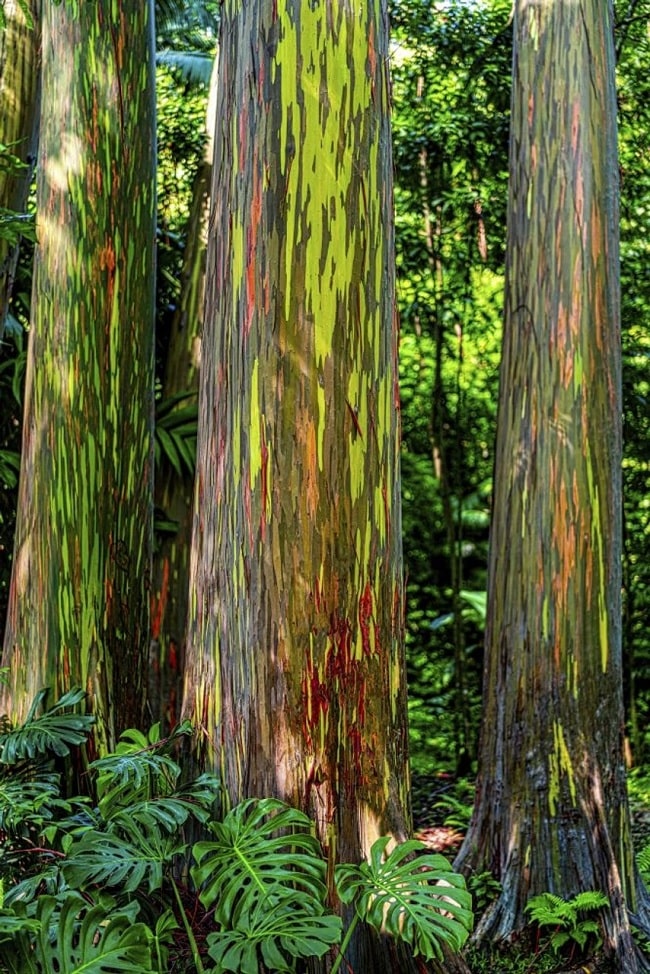
Shedding Secrets: Unveiling the Rainbow
The magic behind the rainbow eucalyptus’s colorful bark lies in its continuous renewal process. Unlike most trees with a single, protective outer layer, the rainbow eucalyptus sheds its bark in patches throughout the year. As the older outer bark loosens and peels away, a vibrant underlayer is revealed. This underlayer, rich in pigments called eucalyptus oils and flavonoids, is initially green. However, with exposure to air and sunlight, the green pigments oxidize, creating a stunning spectrum of colors – from fiery oranges and reds to calming blues and deep purples.
This continuous shedding and color-changing process creates a kaleidoscope effect on the tree’s trunk. The vibrant green sections represent the newly exposed underlayer, while the maturing bark showcases a range of colors as it oxidizes. The older, outermost bark eventually flakes off, revealing the green underlayer once again, completing the cycle.
The rainbow eucalyptus’s colorful bark isn’t just visually captivating; it also serves an important biological function. The shedding process helps the tree stay healthy by removing older, potentially disease-ridden bark. Additionally, the freshly exposed, brightly colored layers are thought to deter insects from boring into the tree’s inner wood.
So, the next time you hear about the rainbow eucalyptus tree, remember it’s not just a pretty face. This Southeast Asian wonder is a testament to nature’s artistry and the ingenious adaptations of living organisms.
From Seed to Splendor: The Rainbow Eucalyptus Through Time
The journey of a rainbow eucalyptus tree (Eucalyptus deglupta) is a fascinating one, transforming from a tiny seed into a towering spectacle of color. Let’s delve into the natural history of this remarkable tree, exploring its preferred habitat, impressive lifespan, and ecological significance.
Thriving in Tropical Delights
Rainbow eucalyptus trees are native to the lush rainforests of Southeast Asia, specifically Indonesia, Papua New Guinea, and the Philippines, some of the most diverse and vibrant biomes on Earth. These regions boast warm temperatures, high humidity, and abundant rainfall – perfect conditions for the rainbow eucalyptus to flourish. Their fast-growing nature allows them to quickly reach the forest canopy, where they soak up sunlight and thrive.
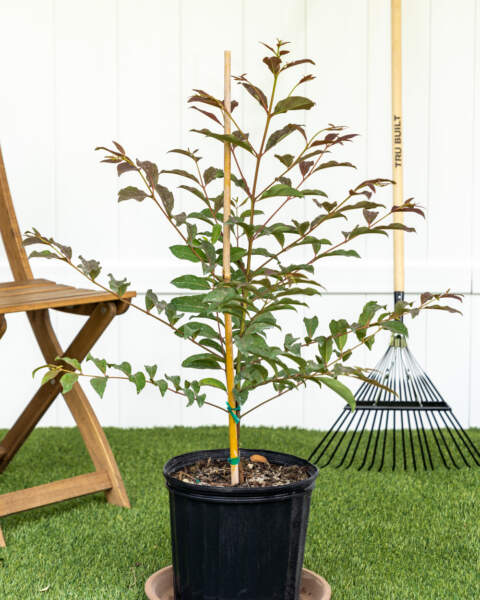
A Long and Colorful Life
Under ideal conditions, a rainbow eucalyptus tree can live for a remarkable 200 to 300 years. This translates to centuries of continuous bark shedding and vibrant color displays. Their rapid growth rate, often exceeding three feet per year in their youth, allows them to reach staggering heights – some specimens can tower over 200 feet!
A Rainforest Steward
The rainbow eucalyptus plays a vital role in the health and biodiversity of its rainforest home. Their fast growth and subsequent leaf litter decomposition contribute to the nutrient cycle of the rainforest floor, enriching the soil and supporting a diverse range of plant and animal life. Additionally, the peeling bark creates a habitat for insects and small animals, further contributing to the rainforest’s intricate web of life.
Beyond Aesthetics: Potential Uses
While the rainbow eucalyptus tree is primarily prized for its captivating beauty, it also holds potential for commercial uses. The fast-growing nature and strong wood fibers make it a valuable source of pulpwood for paper production. Additionally, eucalyptus oil extracted from the leaves has a range of potential applications, including as a natural antiseptic and insect repellent. However, it’s crucial to note that responsible harvesting practices are essential to ensure the sustainability of these magnificent trees.
The rainbow eucalyptus tree’s journey from a tiny seed to a towering spectacle of color is a testament to the wonders of nature. Its impressive lifespan, ecological significance, and potential uses make it a truly remarkable tree.
Shedding Secrets: The Colorful Layers of Rainbow Eucalyptus Bark
The captivating multicolored cloak adorning the rainbow eucalyptus tree (Eucalyptus deglupta) isn’t just a pretty face; it’s a result of a fascinating biological process – the continuous shedding of its bark. Unlike most trees with a single, unchanging outer layer, the rainbow eucalyptus undergoes a remarkable cycle of bark renewal, creating a vibrant tapestry of greens, oranges, blues, and purples. Let’s peel back the layers (pun intended) and delve into the science behind this unique phenomenon.
A Farewell to the Old: Making Way for the New
The shedding process in rainbow eucalyptus trees is driven by a layer of tissue called the phelloderm. This inner layer actively divides, pushing outwards and causing the older, outer bark to loosen its grip on the tree’s trunk. As the rainbow eucalyptus matures, patches of the outer bark begin to crack and flake away, revealing a fresh, vibrant green underlayer.
This green underlayer is rich in compounds called chlorophyll, which gives plants their characteristic green hue. However, the colorful spectacle doesn’t stop there. As the newly exposed green bark interacts with air and sunlight, a fascinating transformation occurs.
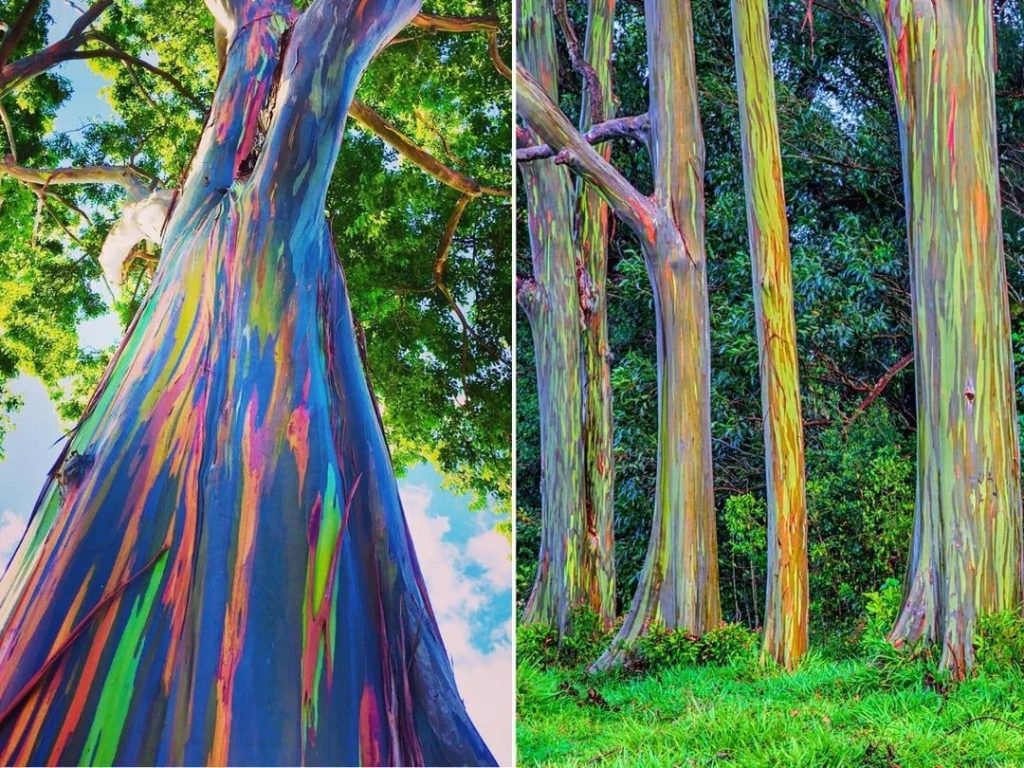
From Green to Rainbow: The Power of Oxidation
The vibrant green underlayer of the rainbow eucalyptus bark contains pigments called flavonoids and tannins. These pigments, along with chlorophyll, react with oxygen in the air through a process called oxidation. Just like a cut apple browning, this oxidation process alters the chemical structure of the pigments, leading to a dazzling array of colors.
For instance, as the green chlorophyll breaks down, it reveals yellow and orange hues. Meanwhile, the flavonoids and tannins oxidize into a spectrum of blues, purples, and even maroons. This continuous cycle of shedding, oxidation, and color change ensures that the rainbow eucalyptus’s trunk is always adorned with a mesmerizing display.
More Than Just Beauty: The Benefits of Shedding
The unique bark shedding process of the rainbow eucalyptus isn’t just aesthetically pleasing; it serves several crucial functions. Shedding old bark helps the tree stay healthy by removing layers that may harbor disease or pests. Additionally, the freshly exposed, brightly colored bark is thought to deter insects from boring into the tree’s vital inner wood. This continuous renewal process allows the rainbow eucalyptus to thrive for centuries, adding a touch of magic to the rainforest ecosystem.
A Spectrum Unveiled: The Science Behind the Rainbow
The mesmerizing colors adorning the rainbow eucalyptus tree (Eucalyptus deglupta) are a captivating display of nature’s artistry. But what exactly creates this vibrant spectacle? The secret lies in a fascinating interplay between the tree’s bark shedding process and the science of pigments. Let’s unravel the scientific reasons behind the rainbow eucalyptus’ stunning kaleidoscope of colors.
Pigments: The Building Blocks of Color
Imagine a painter’s palette brimming with vibrant hues. Similarly, the rainbow eucalyptus bark boasts its own unique palette of pigments. These pigments are natural compounds within the bark that absorb and reflect specific wavelengths of light. The wavelengths that are reflected are what our eyes perceive as color.
Green at First Glance: Chlorophyll Takes Center Stage
When a patch of bark sheds on the rainbow eucalyptus, it reveals a fresh, green underlayer. This vibrant green hue is primarily thanks to a pigment called chlorophyll. Chlorophyll is essential for photosynthesis, the process by which plants convert sunlight into energy. So, the green underlayer is not just visually appealing; it’s actively working to nourish the tree.
From Green to Rainbow: Oxidation Paints the Town
However, the green underlayer doesn’t stay green forever. As the newly exposed bark interacts with air and sunlight, a fascinating transformation occurs. This process, called oxidation, alters the chemical structure of other pigments present in the bark – namely flavonoids and tannins.
Think of it like this: when you cut an apple, it turns brown. This is because the apple flesh is exposed to oxygen, causing a similar oxidation process. In the rainbow eucalyptus, oxidation breaks down chlorophyll, revealing underlying yellow and orange hues.
But the magic doesn’t stop there! The oxidation of flavonoids and tannins creates a whole new spectrum of colors. These pigments oxidize into various shades of blue, purple, and even maroons. This interplay between chlorophyll breakdown and pigment oxidation is what paints the rainbow eucalyptus’s trunk with its mesmerizing rainbow effect.
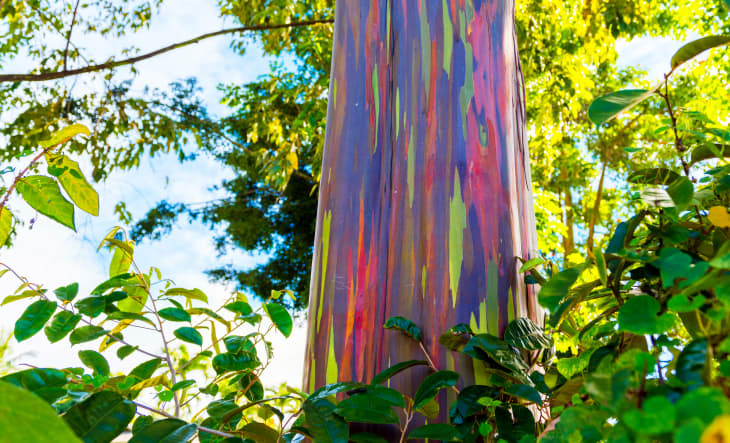
A Continuous Cycle of Color
The shedding process in the rainbow eucalyptus is a continuous cycle. As older, colorful bark flakes off, a fresh green underlayer is revealed. This green underlayer then undergoes oxidation, creating a new band of vibrant colors. This ongoing process ensures that the rainbow eucalyptus is always adorned with a captivating display, adding a touch of wonder to the rainforest landscape.
Beyond Beauty: The Ecological Importance of the Rainbow Eucalyptus
The captivating rainbow hues of the rainbow eucalyptus tree (Eucalyptus deglupta) might steal the show, but this remarkable tree plays a vital role in the health and biodiversity of its native rainforest ecosystem. Beyond its stunning appearance, the rainbow eucalyptus boasts several ecological adaptations that contribute significantly to the rainforest’s delicate balance.
Fast Growth, Big Impact
One of the key ecological contributions of the rainbow eucalyptus is its rapid growth rate. These trees can shoot up at an impressive pace, exceeding three feet per year in their youth. This rapid growth allows them to quickly reach the forest canopy, where they soak up sunlight and contribute to the overall health of the rainforest ecosystem.
Their fast growth also leads to the production of a significant amount of leaf litter. As these leaves fall and decompose on the rainforest floor, they become a valuable source of nutrients. This organic matter feeds the soil, promoting the growth of other plants and fungi, ultimately enriching the rainforest’s biodiversity.
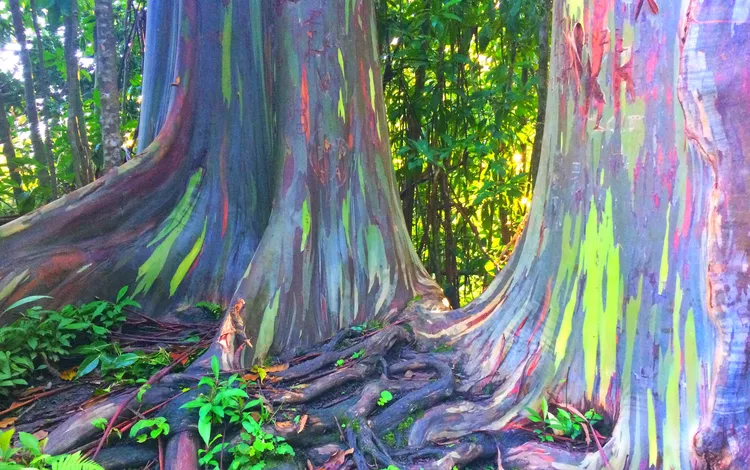
Shedding for a Purpose: Creating a Haven for Life
The unique bark shedding process of the rainbow eucalyptus isn’t just visually captivating; it also contributes to the rainforest’s ecological balance. As the outer bark peels away, it creates a rough, textured surface on the trunk. This textured bark provides a valuable habitat for a diverse range of insects and invertebrates. These tiny creatures find shelter within the bark’s crevices, playing a crucial role in the rainforest’s food chain by decomposing organic matter and serving as prey for larger animals.
Furthermore, the shedding bark adds to the nutrient cycle of the rainforest floor. As the bark flakes off and decomposes, it releases essential minerals back into the soil, further enriching the environment and promoting plant growth. This continuous cycle of bark shedding and decomposition helps maintain the fertility of the rainforest soil, ensuring a healthy foundation for the entire ecosystem.
A Natural Wonder with Ecological Significance
The rainbow eucalyptus tree is a testament to the beauty and complexity of nature. Its captivating appearance goes hand-in-hand with its vital ecological contributions. From its rapid growth and nutrient-rich leaf litter to its habitat-providing bark and contribution to soil health, the rainbow eucalyptus plays a significant role in the rainforest’s intricate web of life.
A Global Citizen: The Rainbow Eucalyptus Beyond Rainforests
The captivating beauty of the rainbow eucalyptus tree (Eucalyptus deglupta) has transcended its native Southeast Asian rainforests. Human intervention has introduced this vibrant wonder to various parts of the world, where it’s prized for its ornamental value. But how does this “global citizen” fare outside its natural habitat? Let’s explore the potential benefits and drawbacks of planting rainbow eucalyptus trees in different climates.
A Touch of the Tropics: The Allure of the Rainbow Eucalyptus as an Ornamental Tree
The rainbow eucalyptus’ mesmerizing multicolored bark makes it a popular choice for landscaping in warm, humid climates similar to its native rainforests. In areas like California, Florida, and Hawaii, these trees add a unique and exotic touch to gardens and parks, offering a visual reminder of the lush tropics.
Fast Growth, Fast Benefits: Potential Advantages
Rainbow eucalyptus trees offer several potential advantages as ornamental trees. Their rapid growth rate allows them to quickly mature, providing shade and privacy in a relatively short timeframe. Additionally, their fast growth translates to a faster production of wood biomass, making them a potentially renewable resource for pulpwood production in certain regions.
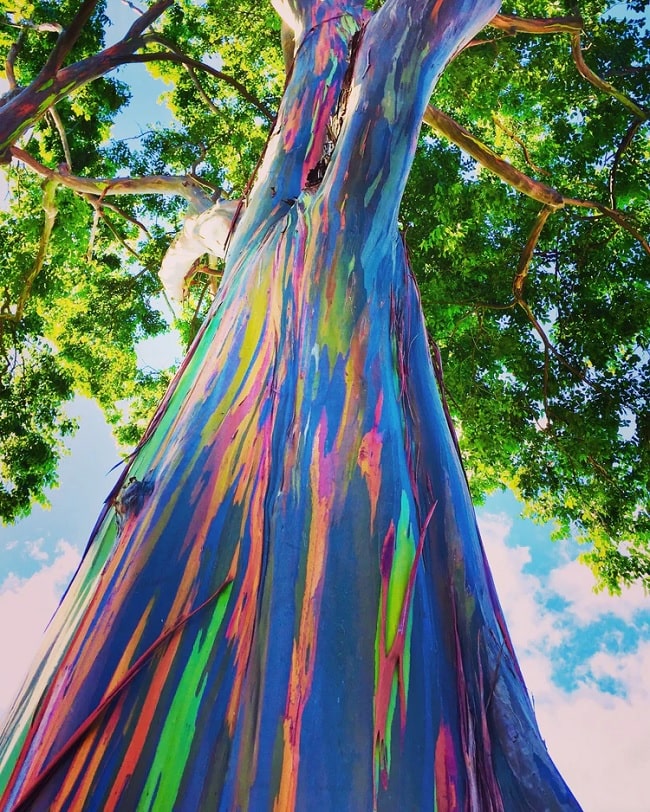
Climate Concerns: Potential Drawbacks to Consider
While the rainbow eucalyptus thrives in warm, humid climates, planting it in areas with distinct seasons or lower humidity levels can pose challenges. These trees struggle in cold temperatures and may not reach their full potential or vibrant color display in drier environments.
Furthermore, the rapid growth rate that makes them desirable as ornamentals can become a drawback in some situations. Rainbow eucalyptus trees can develop aggressive root systems, potentially damaging sidewalks and foundations if planted too close to structures. Their fast growth also means they require regular pruning to maintain a manageable size and shape.
A Balancing Act: Responsible Planting for a Sustainable Future
The introduction of the rainbow eucalyptus to new environments requires careful consideration. Planting these trees in suitable climates and maintaining a safe distance from structures can minimize potential drawbacks. Additionally, responsible harvesting practices are crucial if utilizing them for wood production.
The rainbow eucalyptus’ journey from a Southeast Asian rainforest wonder to a global citizen highlights the importance of understanding a plant’s ecological needs before widespread introduction. By appreciating its beauty and respecting its natural tendencies, we can ensure that this captivating tree continues to add a touch of magic to landscapes around the world.
A Tree of Wonder: The Rainbow Eucalyptus and Our Connection to Nature
The rainbow eucalyptus tree (Eucalyptus deglupta) stands as a testament to the awe-inspiring beauty and ingenious adaptations found in the natural world. From its mesmerizing multicolored bark, a result of a continuous cycle of renewal, to its ecological contributions in its native rainforests, the rainbow eucalyptus is a captivating reminder of the wonders that surround us.
However, despite its resilience, the rainbow eucalyptus faces threats like habitat loss due to deforestation and climate change. These factors highlight the importance of conservation efforts to ensure the survival of this unique tree and the vibrant rainforests it calls home.
A Spark of Curiosity: Exploring the World of Trees
The rainbow eucalyptus is just one example of the countless fascinating trees that grace our planet. From the towering redwoods of California to the resilient baobab trees of Africa, each species offers a glimpse into the remarkable diversity of the plant kingdom. Feeling inspired by the rainbow eucalyptus? Why not delve deeper into the world of trees? Explore local arboretums, research other unique tree species, or simply appreciate the trees in your own neighborhood.
Planting a Seed for the Future: A Call to Action
Trees play a vital role in maintaining a healthy planet, providing us with oxygen, filtering air and water, and creating habitats for countless species. Planting a tree, whether it’s a native species or a well-suited ornamental variety, is a simple yet impactful way to contribute to a greener future. By learning about and appreciating trees like the rainbow eucalyptus, we can foster a deeper connection with nature and inspire action to conserve these irreplaceable wonders.
So, the next time you encounter a tree, take a moment to marvel at its beauty and complexity. Remember, the rainbow eucalyptus is a dazzling reminder that even the most ordinary things in nature can hold extraordinary secrets waiting to be discovered.


